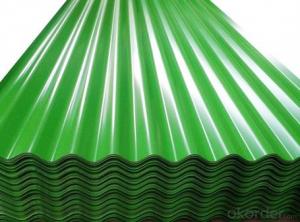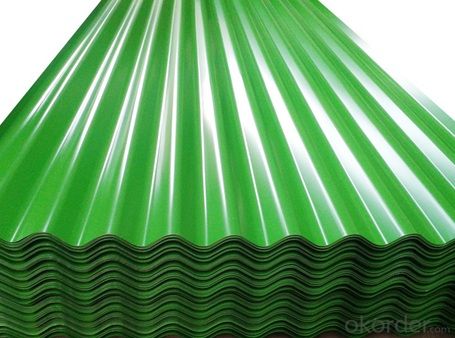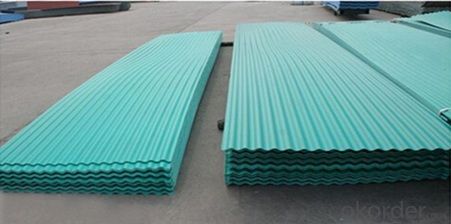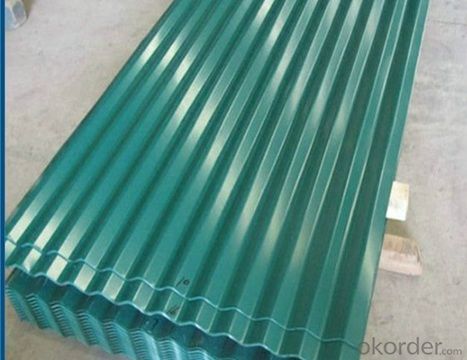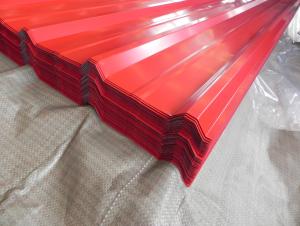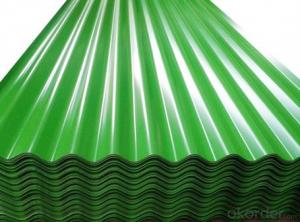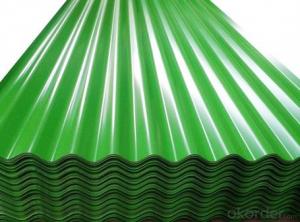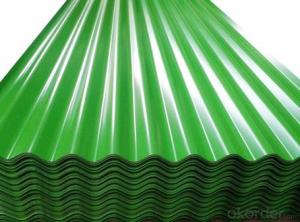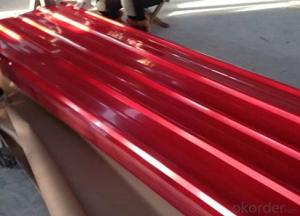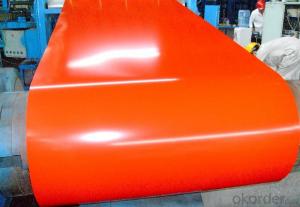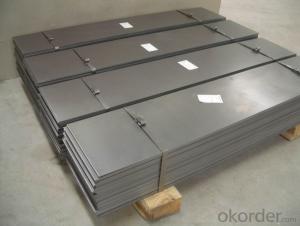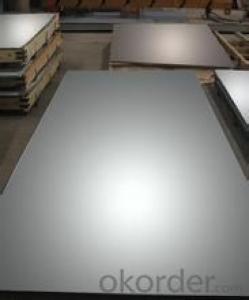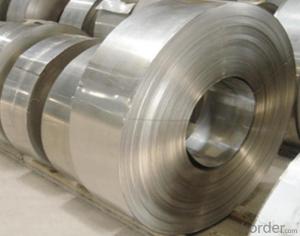Premium Colored Corrugated Roofing Metal Sheet
- Loading Port:
- Tianjin
- Payment Terms:
- TT OR LC
- Min Order Qty:
- 50 m.t.
- Supply Capability:
- 2000 m.t./month
OKorder Service Pledge
OKorder Financial Service
You Might Also Like
Specification
Product Brief Introduction
Premium Colored Corrugated Roofing Steel Sheet
--- Corrosion resistance: Pre-coated steel offers excellent corrosion resistance achived through continuous hot DIP galvanization and corrosion resistant primer/polyester coating. Protection is achieved when zinc and steel are together in the presence of moisture; The zinc protects the steel by galvanic action
Product Features
. Traditional aesthetics outlook
. Suitable for new house or renovation.
. Less joints, watertight
. Long life service
. Tedun also provide relative ridge cap, fasteners and other accessories
Product Specification
Standard:ASTM, GB,JIS,JIS G3302 ASTM 755 EN10169
Grade: DX51D CGCC CS
Thickness: 0.13mm~3.0mm,
Width: 1250,600-1250mm
Coil weight:3-12 MT
Coil ID:508/610mm
Chemical composition:
C | Si | Mn | Cr | Ni | P | S |
0.150 | 0.476 | 11.231 | 12.50 | 0.900 | 0.039 | 0.010
|
FAQ
How long will we receive the goods ?
45days after receiving workable L/C
2. how do you control the quality ?
we have our own quality control department ,we will arrange QC person to see the production line ,when goods finish ,before shipment ,our QC person will check the quality as per our test report request ,if the goods is ok ,then we issue the test report ,and we allow the goods shipping ,otherwise will not allow ship the goods.

- Q: Do steel strips come in different lengths?
- Yes, steel strips come in different lengths to accommodate various needs and applications.
- Q: What are the welding techniques used for steel strips?
- Some commonly used welding techniques for steel strips include butt welding, lap welding, and spot welding.
- Q: Can steel strips be used for making electrical connectors?
- Yes, steel strips can be used for making electrical connectors.
- Q: Specification and use of cold rolled strip
- Cold rolled strip steel: widely used in construction machinery, transportation machinery, construction machinery, lifting machinery, agricultural machinery and light industry, civil and other general structural parts and stamping parts.
- Q: How are steel strips used in the production of tubes?
- Steel strips are commonly used in the production of tubes due to their strength and versatility. The manufacturing process typically starts with a steel strip, which is slit into narrower strips to achieve the desired width and thickness for the tube. These strips are then fed into a tube mill, where they are shaped into a cylindrical form. The steel strips are first passed through a series of rollers that gradually bend and shape them into the desired tube shape. These rollers can have various configurations, depending on the specific requirements of the tube being produced. The strips are continuously welded along their length to form a seam, which is typically done using high-frequency induction welding or electric resistance welding. Once the welding is complete, the tube is further processed to ensure it meets the desired specifications. This may involve additional shaping, such as cold forming or sizing, to achieve the required dimensions and tolerances. The tube may also undergo heat treatment or other finishing processes to enhance its strength, durability, or surface qualities. Steel strips play a crucial role in the production of tubes as they provide the raw material necessary to create the cylindrical shape. Their high strength and formability allow for the creation of tubes with precise dimensions and consistent quality. Furthermore, steel is known for its excellent mechanical properties, making the resulting tubes suitable for a wide range of applications across various industries, including construction, automotive, and manufacturing.
- Q: How are steel strips used in the production of fasteners?
- Steel strips are commonly used in the production of fasteners due to their durability and strength. Fasteners, such as screws, nails, bolts, and rivets, require a sturdy material that can securely hold objects together. Steel strips provide the necessary strength and resilience to withstand the pressure and tension often experienced by fasteners. In the production process, steel strips are typically cut into smaller pieces and shaped into the desired form for the specific type of fastener being manufactured. For example, screws require a threaded section for secure fastening, while nails are typically straight with a pointed end. The steel strips are then often subjected to various treatments to enhance their properties. Heat treatment, for instance, can improve the hardness and resilience of the steel, making it more resistant to deformation and wear. Coating the steel strips with materials like zinc or chromium can also enhance their corrosion resistance, which is crucial for fasteners as they are often exposed to harsh environmental conditions. Once the steel strips are properly shaped and treated, they go through a fabrication process to form the final fastener. This may involve processes such as cold forging, where the steel strip is pressed into the desired shape using extreme pressure. Cold heading, another common technique, is used to form the head of a screw or bolt. Overall, steel strips play a vital role in the production of fasteners by providing the necessary strength, durability, and versatility required for a wide range of applications. Their ability to withstand high levels of stress and resist corrosion makes steel strips an ideal material choice for fastener production, ensuring the reliability and longevity of the final product.
- Q: What are the factors that affect the corrosion resistance of steel strips?
- The corrosion resistance of steel strips can be influenced by various factors. Here are some important considerations: 1. Steel composition plays a vital role in determining corrosion resistance. The presence of alloying elements like chromium, nickel, and molybdenum can significantly enhance the steel's ability to resist corrosion. These elements create a protective oxide layer on the surface, preventing further corrosion. 2. The condition of the steel's surface also affects its corrosion resistance. A smooth and clean surface is less susceptible to corrosion compared to a rough or contaminated surface. Any defects or impurities on the surface can compromise its resistance to corrosion. 3. Environmental exposure is another crucial factor. The type and severity of the environment in which the steel is exposed can impact its corrosion resistance. Factors like humidity, temperature, presence of corrosive chemicals or gases, and oxygen exposure levels all contribute to corrosion. 4. The pH level of the environment is significant. Steel is more prone to corrosion in acidic environments, while it tends to be more resistant in alkaline environments. 5. Applying protective coatings or treatments to the steel's surface can enhance its corrosion resistance. Examples include galvanizing, painting, or using corrosion inhibitors. 6. Mechanical stress can also affect corrosion resistance. Bending, stretching, or abrasion can disrupt the protective oxide layer, making the steel more vulnerable to corrosion. 7. The microstructure of the steel, including grain size and the presence of impurities or defects, can impact its corrosion resistance. A fine-grained and homogeneous microstructure generally exhibits better resistance to corrosion. By considering these factors and implementing appropriate measures, the corrosion resistance of steel strips can be improved, ultimately extending their lifespan in various applications.
- Q: Can steel strips be heat treated to improve their properties?
- The properties of steel strips can be enhanced through heat treatment. Heat treatment involves controlled heating and cooling of steel to modify its physical and mechanical properties. This method can improve the hardness, strength, toughness, and resistance to wear or corrosion of the steel. Steel strips can undergo different heat treatment methods, such as annealing, quenching, tempering, and case hardening. Annealing relieves internal stresses and improves ductility by heating the steel to a specific temperature and slowly cooling it. Quenching rapidly cools the steel after heating, increasing its hardness and strength. Tempering, which follows quenching, involves reheating the steel to a specific temperature and then cooling it again to decrease brittleness and increase toughness. Case hardening is another heat treatment technique for steel strips. It hardens the surface layer to enhance wear resistance while maintaining a relatively softer core for toughness. This is accomplished by introducing carbon or nitrogen into the surface layer and then subjecting the steel to heating and cooling. Heat treatment plays a vital role in the production of steel strips as it allows manufacturers to customize the material's properties for specific applications. By carefully controlling the heating and cooling processes, steel strips can be optimized for desired characteristics such as strength, hardness, ductility, and more.
- Q: Can steel strips be used for making precision machined parts?
- Yes, steel strips can be used for making precision machined parts.
- Q: What are the mechanical properties of steel strips?
- The mechanical properties of steel strips include high tensile strength, excellent ductility, good toughness, and high resistance to corrosion and wear.
Send your message to us
Premium Colored Corrugated Roofing Metal Sheet
- Loading Port:
- Tianjin
- Payment Terms:
- TT OR LC
- Min Order Qty:
- 50 m.t.
- Supply Capability:
- 2000 m.t./month
OKorder Service Pledge
OKorder Financial Service
Similar products
Hot products
Hot Searches
Related keywords
